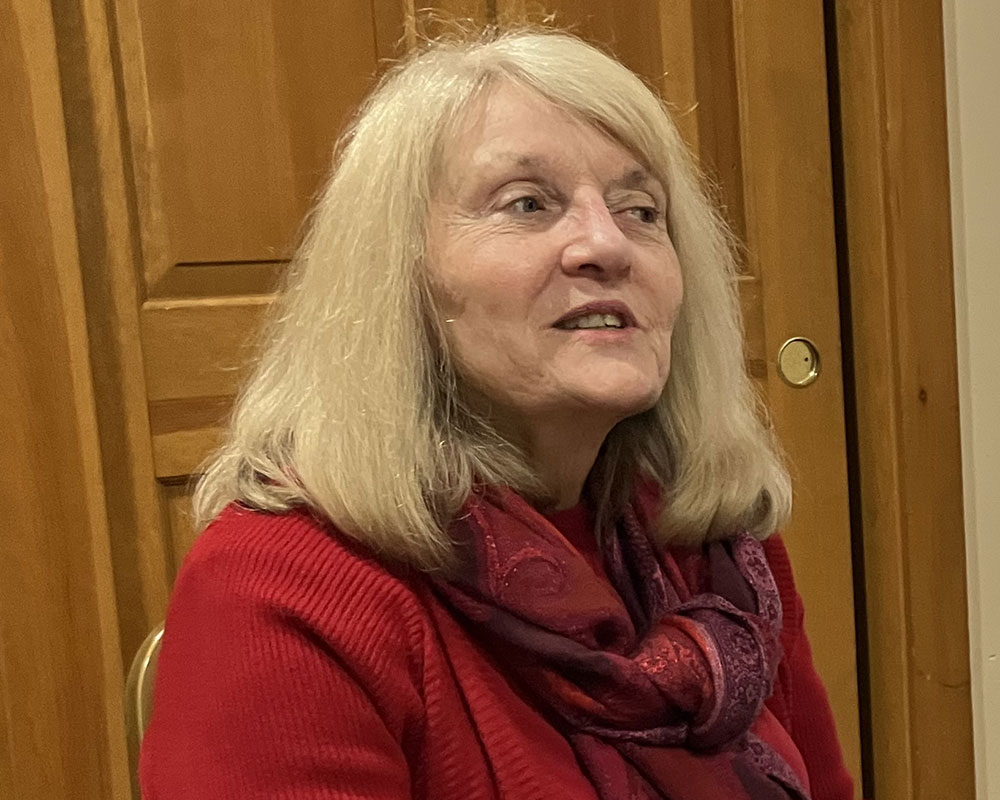After she finished presenting on the history of Haverhill’s Black residents at the public library late last month, an audience member approached Claire Brady, a grant research intern at the Buttonwoods Museum.
She told Brady her great-great grandfather was Robert Brothers. Brady recognized the name. Going through records, she learned he moved to Haverhill from Nova Scotia in the late 1800s. The Canadian province was the end point for the underground railroad, a series of safe houses that allowed enslaved people to flee the American South. As a bricklayer, he helped build the foundation for the Calvary Baptist Church, a center for Black life in Haverhill.
The woman thanked Brady. “I was expecting a little handshake, but she gave me a giant hug afterwards,” Brady said.
The room in the library was full during the Buttonwoods lecture during Black History Month, with around 40 people in attendance, according to Brady and Carol Majahad, the grant project coordinator. For their research into the lives of Haverhill’s Black residents, Majahad focused on the period before 1830 and Brady the period after. Paid for by the Cummings Foundation, the project concludes next month, though Brady said she hopes to continue her research as a volunteer.
Brady, who grew up in Haverhill, said she became interested in telling the stories often left out of the city’s dominant narrative after watching a Ted Talk, “The danger of a single story,” her sophomore year of high school. She said Haverhill’s history is more diverse than some may think.
“When you only talk about one part of history, and other voices get left out, people in those communities, they feel like they’re being pushed to the side,” she said. “When we highlight these sorts of stories, I hope that it brings the city, and its members, closer together and celebrates the city’s history in full.”
The talk covered some of the city’s Black luminaries like William R. Mobley (1873-1948), a wealthy gentleman who owned a boot-blacking shop, a house and three theaters in the city’s downtown. He was so well-connected, Brady said, he sold a dog to J.P. Morgan.
After the heyday of Haverhill’s Black community around the same period, Brady said many dispersed to nearby cities and towns. With so many documents to sift through—newspaper articles, for example—Brady said it will take time to figure out why so many left the city.
Majahad’s part in the research revealed that enslaved people lived in Haverhill, even for some years after 1783, when some argue emancipation in Massachusetts occurred. It’s more complicated than that, Majahad said, because the law in 1783 only meant enslaved people could go before a court to argue their case for their freedom.
In 1795, Majahad found that a Haverhill man willed enslaved people to his wife. While many people enslaved in the North were domestic servants, she also found that some were forced to do hard labor, like building ships and digging docks.
At the same time, prominent Haverhill residents worked toward abolition in the state, and Frederick Douglass visited Haverhill “several” times, Majahad said, where “he was welcomed by some and reviled by others. But there was at least a conversation, or at least a yelling match.”
Museum Educator Antoine Trombino-Aponte told WHAV, “All of this research is great, but if we can’t turn it into something actionable, then it only goes so far. So, the next step, now that Carol and Claire have done all of this uncovering of all these stories, is, we have to turn them into public programs.”
Majahad said her and Brady’s research will be made available in a public database. She said she hopes someone at home with a question can quickly find an answer online. Some of Majahad’s research also included groups that immigrated to Haverhill from other countries. Despite larger concentrations of ethnic groups in Lawrence, Majahad said Haverhill appealed more to some. She speculated the city drew individuals who wanted to make their own way rather than be just another member of a large ethnic community.
Trombino-Aponte said he recently did a presentation in a classroom on Haverhill’s shoe factories of the 1950s. Most of those workers were Hispanic immigrants.
“When I made a point to ask the class, how many of the students had relatives from Spanish-speaking countries, nearly every single child raised their hand, so it goes a long way in delivering information to our audience, when that information is relatable,” Trombino-Aponte said.
Like many of her peers, Brady said she wanted to move away from the city in high school, but is now quite happy living in Haverhill. Learning its history has made her feel a stronger attachment to the city, a sense of pride in belonging to the place.
Brady said a talk in January on the Boston accent by Trombino-Aponte was quite well attended, like her and Majahad’s lecture. This was in stark contrast to when she first started volunteering at the Buttonwoods Museum, just after the city began reopening following pandemic lockdowns. This growing interest in Haverhill’s past energizes her to continue her work.

